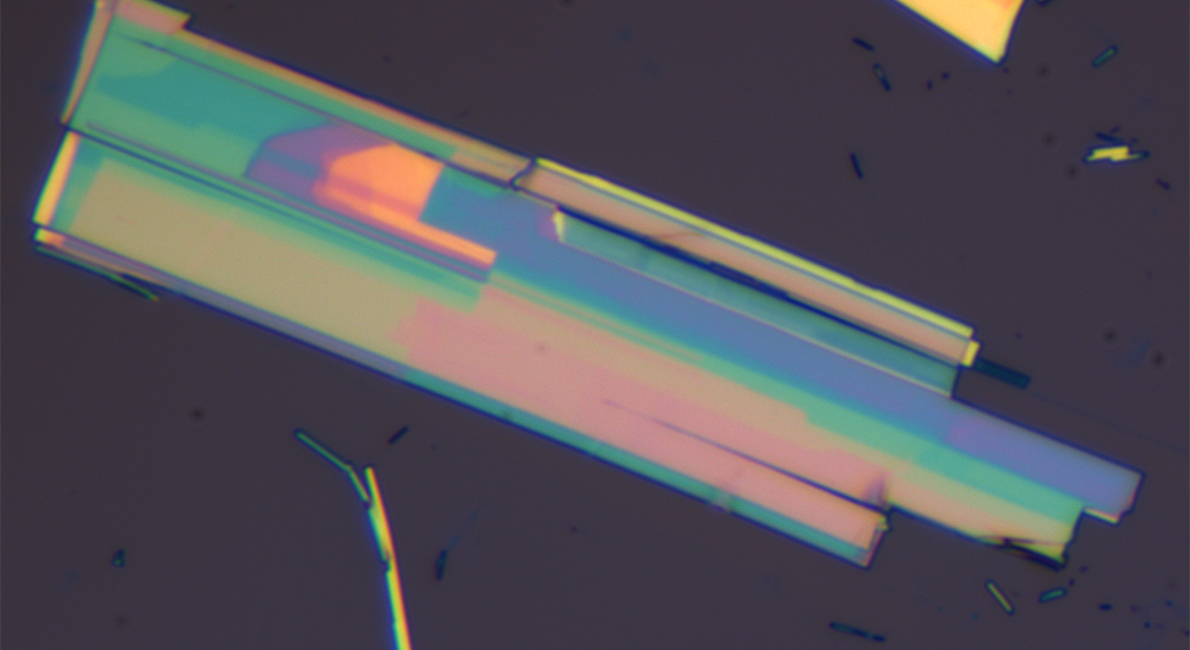Researchers from Professor Urbaszek’s Group at the Technical University of Darmstadt, MIT Boston, Ioffe Institute St. Petersburg, University of Chemistry and Technology Prague, and Toulouse University have recently used polarization-resolved resonant Raman scattering to reveal a 90-degree switch in the linear polarization of scattered light using a SuperK FIANIUM supercontinuum white light laser.
Controlling Light Polarization in CSBr for Advanced Photonic and Quantum Applications
Chromium sulfide bromide (CrSBr) is a promising material in the field of van der Waals materials, known for its remarkable electronic and magnetic properties. These properties arise from its pronounced structural anisotropy (Fig. 1), which means that its structure varies in different directions. This anisotropy leads to several unique phenomena, including a large exciton binding energy [1], which is the energy required to separate an electron from its hole, correlated magneto-transport [2], which refers to the movement of electrons in the presence of a magnetic field, and various magneto-optical effects [3-5], which are changes in the material’s optical properties due to a magnetic field.
The latest research reveals an unexpected effect in CrSBr: a 90-degree switch in the linear polarization of scattered light when the laser excitation energy is changed. This means that the direction in which the light waves oscillate changes by 90 degrees depending on the energy of the laser used to excite the material [6]. This effect was discovered using Raman spectroscopy, a technique that measures the scattering of light to provide information about the material’s vibrational modes. The researchers attributed this polarization switch to a distinctive interaction between electrons and phonons, which are quanta of vibrational energy.
Understanding this electron-phonon interaction in CrSBr could open up new possibilities in several advanced fields. For example, in quantum optics, it could lead to the development of new types of light-based technologies. In sensing, it could improve the sensitivity and accuracy of sensors that detect changes in light. In spintronics, which is a field that studies the spin of electrons for information processing, it could lead to new ways of controlling and manipulating electron spins. By exploring these unique properties and interactions, researchers hope to pave the way for innovative applications in these cutting-edge fields.
![Figure 1. (a) Sketch of CrSBr crystal structure, crystallographic axes a, b, and c are indicated. The figure is reproduced from [6]. (b) Optical image of a typical CrSBr flake, elongated along the a-axis.](https://www.nktphotonics.com/wp-content/uploads/2025/05/crsbr-crystal-structure-superk-nano-and-quantum-technical-university-of-darmstadt.png)
Investigating Electron-Phonon Interactions in CrSBr Using Polarization-Resolved Raman Scattering
Polarization-resolved resonant Raman scattering is a powerful technique used to study how the vibrational modes (how atoms in a material move) interact with the electronic states (the energy levels of electrons) of a material. This method is powerful because it allows researchers to see how these interactions change when the material is excited by a laser.
To capture these fundamental interactions accurately, it’s crucial to use a laser that can precisely adjust its energy across a wide range of wavelengths while maintaining high stability and intensity. For this reason, we chose the SuperK Fianium supercontinuum white light fiber laser from NKT Photonics.
With this type of laser, we can probe different excitation energies, which helps us reveal the resonance conditions that govern polarization switching. In simpler terms, it allows scientists to see how the material’s response changes with different laser energies.
In the case of chromium sulfide bromide (CrSBr), there are three specific vibrational modes known as Ag modes. These modes correspond to out-of-plane atomic vibrations, meaning the atoms move perpendicular to the plane of the material. Each mode has a different phonon energy, which is the energy associated with these vibrations.
When the researchers changed the excitation energy of the laser, they observed that two of these modes (Ag1 and Ag3) did not show any significant change in polarization (the direction in which the light waves oscillate) (Fig. 2, bottom panel). However, the Ag2 mode displayed a rotation of its polarization orientation depending on the excitation energy. This means that the direction of the light waves changed as the laser energy was varied (Fig. 2, top panel).
This effect was consistently observed across samples of varying thicknesses, from few-layer flakes to bulk crystals. The fact that the polarization rotation depends on the energy indicates a coupling between lattice vibrations (the movements of atoms) and electronic transitions (changes in the energy levels of electrons). Understanding this coupling is essential for achieving precise control over light-matter interactions in low-dimensional systems, which are systems where the material’s properties are confined to a few dimensions, such as thin films or nanomaterials.
So, this research helps us understand how the vibrations of atoms in CrSBr interact with the energy levels of electrons, and how this interaction can be controlled by changing the energy of the laser. This knowledge is crucial for developing advanced technologies that rely on precise control of light and matter interactions.
![Figure 2. The top panel presents the polar plot of Raman scattering signal intensity dependent on the polarization rotation angle of A_g^2 mode (terracotta color), while the bottom panel shows the same for A_g^3 mode (blue color) at different excitation energies ranging from 2.33 to 1.96 eV (each column reflects a certain excitation energy marked above columns). Dots correspond to an experimental spectrum; the solid lines are fitting curves. The angle of the polarization orientation of the Raman signal is measured from the direction of the b-axis (0 degrees). The radial axis corresponds to the signal intensity, which differs for each plot; the center point is 0 counts on all plots. The figure is reproduced from [6].](https://www.nktphotonics.com/wp-content/uploads/2025/05/polar-plot-of-raman-scattering-superk-nano-and-quantum-technical-university-of-darmstadt.png)
Towards New Applications
Chromium sulfide bromide (CrSBr) allows us to control the polarization of scattered light by adjusting the laser energy. This capability makes CrSBr a valuable material for advanced technologies. We can use it to develop devices that utilize light for various functions, process data with light instead of electricity, and create more accurate sensors.
The energy-dependent polarization switching enables precise control over light interactions, which we can use for secure communication and highly sensitive detection technologies. This control over light and matter interactions opens up new possibilities in quantum communication and quantum sensing.
Read the white paper: Raman polarization switching in CrSBr
References
[1] Smolenski, S. et al. Large exciton binding energy in a bulk van der Waals magnet from quasi-1D electronic localization. Nat Commun. 16, 1134 (2025).
[2] E. J. Telford, et al. Adv. Mater. 32, 2003240 (2020).
[3] K. Lee, et al. Magnetic order and symmetry in the 2D semiconductor CrSBr. Nano Lett. 21.8, 3511-3517 (2021).
[4] N. P. Wilson, et al. Interlayer electronic coupling on demand in a 2D magnetic semiconductor. Nat. Mater, 20.12, 1657-1662 (2021).
[5] J. Klein, et al. Sensing the local magnetic environment through optically active defects in a layered magnetic semiconductor. ACS Nano 17.1, 288-299 (2022).
[6] P. Mondal, et al. Raman polarization switching in CrSBr. npj 2D Mater. Appl., 9.1, 22 (2025).





